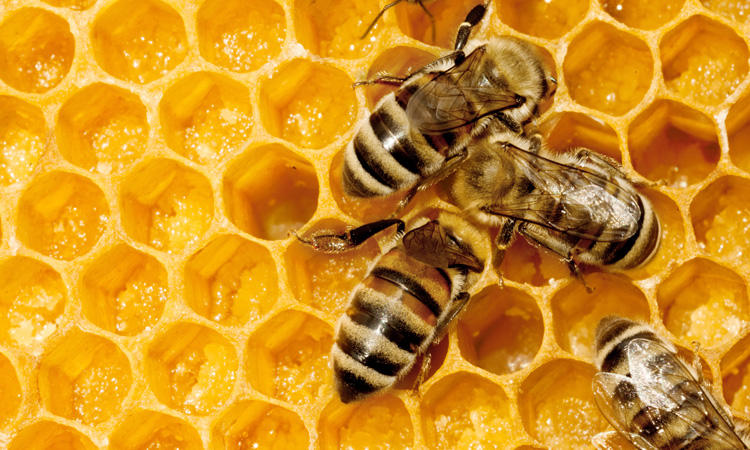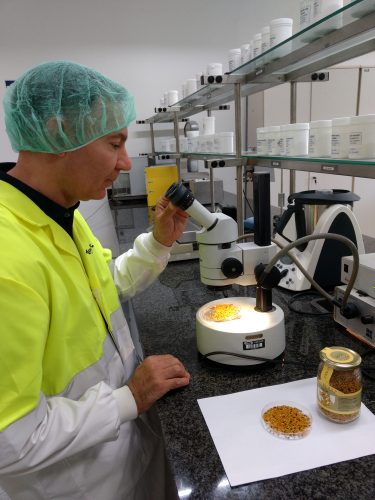Antioxidants in honey and chocolate
- Like
- Digg
- Del
- Tumblr
- VKontakte
- Buffer
- Love This
- Odnoklassniki
- Meneame
- Blogger
- Amazon
- Yahoo Mail
- Gmail
- AOL
- Newsvine
- HackerNews
- Evernote
- MySpace
- Mail.ru
- Viadeo
- Line
- Comments
- Yummly
- SMS
- Viber
- Telegram
- Subscribe
- Skype
- Facebook Messenger
- Kakao
- LiveJournal
- Yammer
- Edgar
- Fintel
- Mix
- Instapaper
- Copy Link
Posted: 8 January 2020 | Francesc Ventura-Coll | No comments yet
In a world where ingredients must work hard to earn their place at the discerning consumer’s table, Francesc Ventura-Coll, Business Development and Engineer Manager at Mondelēz International, highlights why firm favourites such as honey and chocolate deserve to stay.


Health and honey
Bees collect pollen from plant anthers and then mix it with a small dose of the secretion from salivary glands or flower nectar to form spherical pollen loads, which are transported to the hive. In the hive further elaboration takes place. The raw material, pollen grains, differ in shape; colour; size; weight and chemical composition depending on botanical origin. The worldwide honeybee products author Josep Serra Bonvehí,* with whom I write, has defined the main composition and quality characteristics. Fresh collected pollen requires a drying process to make it shelf-stable. Honeybee pollen is nutritionally interesting for its protein and free amino acid content. If proper drying is not achieved, proline and amino acid of low protein value increases. Another of the standards for EU pollen is to meet a minimum of two percent of free amino acids.1,2
These dietetic food ingredients have been compared with the largely more tasteful and convenient cocoa and chocolate products, which also contain natural polyphenols such as cathechins
Moreover, honeybee pollen also contains polyphenol gycosides and flavonoids,3 carotene, lycopene and tocopherols (vitamin E), which are linked to botanical origin and therapeutic applications. Pollen that is rich in rock-rose (Cistus sp) can be found in Southern Europe. Among the rock-rose species, Cistus ladaniferus is particularly interesting, but can only be found in certain areas of western Spain. This kind of pollen is rich in the flavonoids quercetin and rutin, which have been used extensively in medical studies in Japan.4 Rock-rose does not, however, produce nectar and therefore, there is no honey from this origin, but we can have the active principles concentrated in its honeybee-collected pollen. The shape of the Cistus pollen (Cistaceae, rock-rose) can be easily confused with the shape of the Citrullus pollen (Cucurbits, watermelon), which abounds in Chinese honeybee pollen.5 A quality indicator of at least 200mg/Kg of the rutin component has been set to avoid any confusion and to assure the presence of the active components.
Social media channels are also aware of the potential properties of Cistus honeybee pollen. For instance, the television channel MBN from South Korea, which produces TV programmes on healthy living, travelled to Barcelona to film our laboratory work and interview me. The result featured in the TV programme, “Remove trash and inflammation in your body”.6,7 Flavonoids, which have synergistic effects with phytosterols, are all considered hypotensive, anti-inflammatory and antioxidant. Japanese medical studies use the term “cell markers” to mean substances that can induce a positive effect in the body. Studies are progressing to obtain a ‘hydrolysed’ pollen,8 in which active components could be released to increase therapeutic efficiency. In Japan, studies on propolis hydrolisates are also being carried out.
Propolis, dietetic natural antioxidant
Honeybee propolis is a complex mixture of natural sticky, gummy and resinous components, including flavonoids, terpens, ß-esteroids and aromatic aldehydes, which are collected by honeybees from the buds of various trees and used mainly for asepsis of the hive. Honeybee propolis is, without a doubt, an effective free radical quencher, better, for instance, than vitamin E.
Depending on its botanical sources, propolis contains highly variable amounts of flavonoids, which correlate to antioxidant activity.9 A higher flavonoid content and lower wax content equates to more antioxidant activity. The flavonoid patterns are sufficiently distinctive to permit discrimination between propolis from China, Uruguay and Brazil.10 Strong antioxidant activity was found in samples containing at least 80mg/g of flavonoids – primarily pinobanskin, pinocembrin, chrysin, rutin and galangin.11
Cocoa and chocolate


How to measure antioxidant capacity: TEAC and other methods
The trolox equivalent anitoxidant capacity (TEAC) method is the most common and recommended assay for measuring the antioxidant capacity of foods and drinks. It uses trolox as a substance of reference with which to compare foods: the higher the value, the better. Unit: µmol Trolox equivalents/g food product.13
Some other methods are the ABTS Decolorisation Assay, the DPPH assay, oxygen radical absorbance capacity (ORAC) and ferric reducing ability of plasma (FRAP) assays. FRAP is used mainly in medical studies. The result is expressed as the concentration of antioxidants that have a ferric reducing ability of 1mmol/L of FeSO4. With comparative purposes, the result could be correlated to µmol Trolox equivalents per gram of food product.
For instance, the TEAC value of honey can range from 2 to 6 µmol g-1, in accordance with recent studies that found the highest antioxidant capacity in the darkest coloured honey.14 Honeybee-collected pollen presents an average value of 17µmol g-1. In the case of propolis, depending on its origin and composition, it could be between 200 and 1,400 µmol g-1. Propolis is always consumed diluted, principally within honey.
Cocoa powder from beans show TEAC values between 16 and 40 µmol g-1 – the variation can be related to variety and geographical origin.15 The TEAC value is averaged as 20µmol g-1 in chocolate with 70 percent cocoa, and 31µmol g-1 in chocolate with 85 percent cocoa. In milk chocolate the availability is reduced and the average value decreases to 11µmol g-1.
Intake directions and claim suggestion
In accordance with European legislation (EU Regulation 1924/2006),16 honeybee pollen is considered a functional food, admitting “claims” such as: a) improving the physical state; b) improvement of digestion and prebiotic effect. Between 20g and 50g of pollen are recommended as a daily intake, preferably before meals. Two dessert spoons before breakfast are equivalent to approximately 20g. Most common antioxidant claims on foods are supported by the EU Regulation 432/2012,17 based on vitamin E, also present in honeybee pollen in low percentage, but the substances to highlight here are flavonoids.
Some honeys, such as avocado honey, have an interesting flavonoid composition, as well as (-)-epicathechin and catechin
Propolis is frequently mixed with honey. A content of three percent of propolis in honey is sufficient to provide a functional product, rich in flavonoids. When propolis is presented as a liquid extract, two drops added to water or fruit juice is the recommended amount to take. Some honeys, such as avocado honey, have an interesting flavonoid composition, as well as (-)-epicathechin and catechin.18
Similar to honeybee products, (-)-epicathechin characterises flavanols in cocoa powder and dark chocolate as the main biological attribute, as stated in Commission Regulation EU 851/2013,19 with topics addressed on the major sources of flavanols in the human diet, the bioavailability as “markers” for “health benefit” and the biological function. The claim might be used only for cocoa beverages (with cocoa powder) or for dark chocolate pieces, or tablets that provide at least a daily intake of 200mg of cocoa flavanols with a degree of polymerisation 1-10. This scientific approach could be the basis for developing convenience foods, such as biscuits or chocolate products, with healthy natural ingredients and, crucially, the ability to accurately communicate the benefits of these products to the consumer.
References
To view the list of references, click here.
Acknowledgement
*J. Serra-Bonvehí, MIELSO, SA, Research & Development, Almassora, Castelló, Spain ([email protected]). Natural food biochemist and honeybee products recognised referent researcher and journal reviewer.
About the author
Francesc Ventura-Coll is Business Development and Engineering Manager at Mondelēz International, Meals category. After completing a Food Engineer´s degree from Agricultural High-school (UPC) and a Masters degree in food science and Technology (UAB), he worked at a food research institute (IRTA) in the fields of honeybee products, nuts and cocoa, publishing and reviewing articles. He worked for several years in large multi-national food companies on sweets and biscuits in analytical research and quality assurance, with brands such as Oreo, Lu biscuits, Milka, Suchard and Royal. He is a member of ACCA-IEC (Food science association based in Barcelona).








